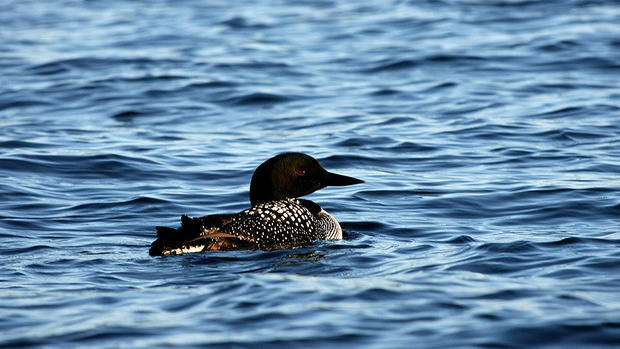New England Sees Record Number Of Loons In Several States
CONCORD, N.H. (AP) — Loons are thriving in New England, with record numbers documented this year because of increased protections for the iconic bird known for its black head and haunting calls at dusk.
New Hampshire saw a slight increase to 313 pairs in 2019 while Vermont had an all-time high of 101 nesting pairs — the highest number recorded since 1978. Maine, which has the largest common loon population in the eastern United States, saw its overall number dip slightly this year. But the 3,129 birds counted was still almost double what was counted in the 1980s.
"Vermont is the star," said Loon Preservation Committee Executive Director Harry Vogel. "It's an exception to the rule which has seen a gradual and slow recovery in the Northeast. ... This has not just happened. We have made it happen through intensified conservation efforts."
The birds have seen their numbers steadily rise for several decades. Loon populations are considered stable and healthy in most parts of North America. According to the latest figures from Cornell Lab of Ornithology's Birds of North America, there are as many as 15,500 pairs in the United States, with the largest populations in Alaska and Minnesota.
Their recovery has been slower in places like New Hampshire as a result of coastal development, lead poisoning from ingesting fish tackle and warmer conditions that impact their ability to breed. A small but growing number of birds have died from avian malaria, including three loons in New Hampshire this year and one in Maine.
Vogel, a senior biologist who has worked to conserve the birds in New Hampshire for 22 years, said the latest numbers in the Granite state were worth celebrating since they are a record. But he lamented that the growth remains slow, with only four more pairs counted this year than in 2018. Five years ago, there were fewer than 300 pairs.
"We are only growing at like 1 or 1.5% a year over the past decade," Vogel said. "Those gains are hard won. ... We're still being successful in helping loons cope with their growing challenges in New Hampshire but it also tells me that there is no such thing as a spare loon."
Vogel credited the recovery with greater protection of nesting sites as well as a program that places dozens of floating rafts in the water for the birds to use as nests. There also has been a campaign in New Hampshire to do away with lead tackle, including a 2016 law prohibiting its use and a program that offers anglers cash vouchers for turning in their old sinkers and jigs.
Vermont, too, credited efforts to protest nesting sites along with increased monitoring for the successful breeding season. It has gone from from seven breeding pairs in 1983 to over 100 this year.
"Vermont's loon project is a tremendous success story," Vermont Fish and Wildlife Department bird biologist Doug Morin said in a statement.
"Many areas where loons are nesting on Vermont's lakes are surrounded by signs reminding people to give loons the space they need, but not all nesting areas are marked," said Morin. "We ask people to enjoy loons from a distance, whether they are in a motorboat, a canoe or a kayak."
The resurgence of loons in Maine has happened alongside new protective laws and increased conservation interest in the birds. A law similar to New Hampshire's banning fishing tackle and a "no wake" law near shorelines have been beneficial, said Tracy Hart, a wildlife ecologist with Maine Audubon. The "no wake" law is helpful because waves created by boats can flood out the birds' nests.
But this year's numbers in Maine illustrate the challenge facing the bird. There were 3,129 bird counted, down from 3,269 in 2018.
"On the ground this year, loon counters reported some nest flooding from early rains, some parents leaving their nests in the early season because of high black fly numbers, and there were reports of predation as a result of increasing bald eagle populations," Hart said. "On the other hand, there were some lakes that reported record numbers of loons ... this year or the first successful chick rearing in a number of years."
AP Writer Patrick Whittle in Portland, Maine contributed to this report.
(© Copyright 2019 The Associated Press. All Rights Reserved. This material may not be published, broadcast, rewritten or redistributed.)




